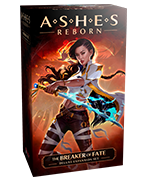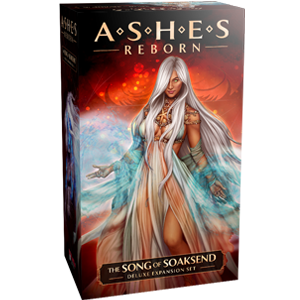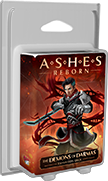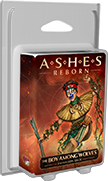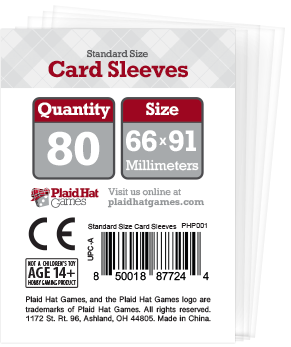Re-Constructed Deck - The Ocean's Warden
Captain Flag's Fly Fishing Fun
Welcome back, Ashes players, to another installment of Re-Constructed. We’re about to have a whale of a time…deck. Because it’s a time deck. With a whale in it. I’m hilarious.
Hopefully, you’re already aware of the deck building restrictions we’re working with; if not, read the last Re-Con article (or any of the previous ones). For all the time magic Phoenixborn, we’re also assuming you have the Breaker of Fates, as time dice will obviously be required to play them. Today’s deck will be exploring the wonders of the deep and really focusing on their strengths. Magnifying them, if you will.

The Ocean’s Warden (Re-Tristan)
5x Sympathy Dice, 5x Time Dice
1x Summon Tidal Crab
2x Summon Prism Tetra
2x Summon Seaside Snapper
2x Beast Warrior
2x Darkwater Hunter
3x Standard Bearer
2x Invigorate
2x Summon Radiant Leviathan
2x Tidal Shift
3x Tsunami Shot
3x Wave Crash
2x Ocean’s Gift
2x Crescendo
2x Flash Strike
Definitely the most convergent aspect between sympathy and time magic is that of status tokens, and Tristan’s deck has no shortage of them. Tidal Crabs donate them pretty freely, Seaside Snappers will munch on your leftover Tetras for them, and it’s incredibly easy to stockpile up with Radiant Leviathan and Ocean’s Gift. Not to mention with your massive status pools, Wave Crash is always available to push an advantage for you. Among the rest of the cards are curios like Darkwater Hunter, Tidal Shift, Stand Still and the extremely bully Tsunami Shot, all cards that just completely flood your opponent in stifling conditions. On its own, Tristan’s precon is actually very well put together, has a solid strategy, and doesn’t contain too many unnecessary cards. Still, we’re nothing if not thorough here at the Re-Con Harbor, so let’s dive in and find some pearls of wisdom.
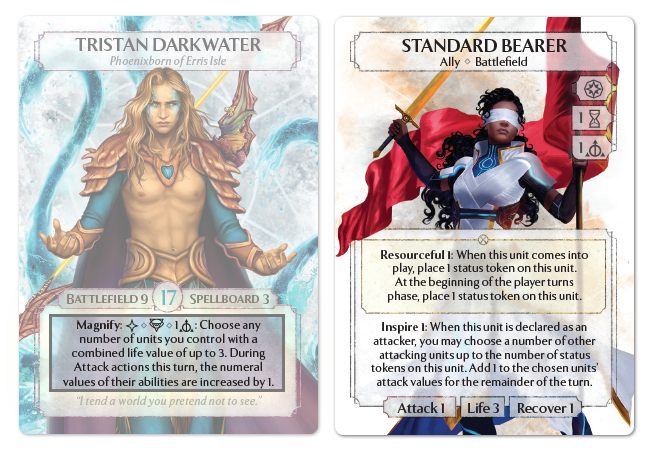
We need to start with Tristan’s ability, and what sorts of play it can enable. The deck’s intended combo is with Prism Tetra, a 1 life unit that comes in packs of 3 (perfect for Magnify), and featuring Group Tactics 1, which Tristan will bump on the following turn for some powerful attacks. Now, swinging for 6 is perfectly respectable, but I think we have the ability to crank Magnify up in other ways, and one in particular is worth highlighting: Standard Bearer. While it may seem like Tristan’s ability is at its best when spread over as many units as possible, sometimes it just comes down to math and circumstance. Standard Bearer can provide basically the same overall bonus at 3 status as your Tetra boost, but can do so with any units, not just the fish. At status 4 and higher, the wake of your bonuses gets out of control as you start by providing as much as 8 additional attack power to your army. The absolute cream of the crop is a Standard Bearer with 8+ status and 8 additional units, providing a total boost of 16 attack through Magnify. While this will never likely happen, this scenario still highlights what makes Standard Bearer such a powerful consideration for the Magnify swarm playline.
Magnify can also affect abilities given to units from outside sources. Ocean’s Gift is perfectly decent on its own, but its bonus gets doubled through Magnify in addition to any other Magnify bonuses that already exist. A Prism Tetra with Ocean’s Gift gets +1 on both Group Tactics and Bestow. And speaking of stacking abilities:
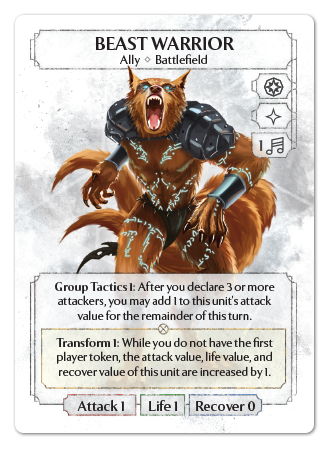
When wielding Magnify, Beast Warrior can be a real…well, beast. Our furry friend may seem like a strange inclusion in this deck, and the strangeness only continues when I tell you that he becomes harder to magnify when his Transform 1 is active (2 life means you won’t be able to Magnify as much when including him). However, his weakness is also his strength; when you magnify Beast Warrior, it increases the number on both Transform and Group Tactics, bringing the unit all the way up to 5/3/3 while attacking with 2 other units. Pretty good for a unit with a base statline of 1/1/1 for 1 die.
That being said, there’s not too much more to improve on with this deck. Outside of cleaning up our numbers and adding a few extra cards – Crescendo and Flash Strike really bolster our wider attacks to be more threatening – the actual strategy of the deck really hasn’t changed. You want to use your Prism Tetras to apply some crazy strong pressure in combination with Tsunami Shot to just take over the early game, then drop a massive looming Radiant Leviathan that threatens to swallow them whole. You can hold down larger threats with Tidal Shift or answer them with Darkwater Hunter, while wider boards prove easier thanks to Tsunami Shot just being the perfect answer to almost anything.
Where you might find yourself suffering a bit is from mass AOE cards like Nature’s Wrath and Meteor, in which a change of strategy might be in order. Bringing out sturdier units like Seafoam Snapper, Tidal Crab, and Standard Bearer can help you weather bigger threats without needing to overcommit too much.

First Five:
So, one new addition we glossed over was Invigorate, probably one of the most unassuming little bits of tech we’ve added to this list. One of the biggest disadvantages to Prism Tetras is that they disappear at the end of the turn unless you fill them with juicy status tokens, something you normally mitigate with your Tidal Crab’s Unburden ability. However, if we don’t put status tokens on our Prism Tetras, we can sometimes fool our opponent into ignoring them. I mean, they’re going to disappear anyways, right? Well, what if they suddenly didn’t?
For our first five, we’re looking to show off the power of this effect. We’re definitely looking to drop Standard Bearer and our books first. Once you summon a Tidal Crab, your plan is to unburden the status onto your Standard Bearer to accelerate the late game very quickly, then summon your Prism Tetras and swing with some big value on Magnify. If your opponent defeats your Standard Bearer before your big swing, that’s less than ideal but you still have Magnify into Tetras for an impressive 6 attack swing. In any case, we don’t want to put any Status tokens on the Tetras themselves, which will probably get our opponent to ignore them. Then, right before the round ends, we play a sneaky Invigorate as a side action targeting all our Tetras (and/or Tidal Crab if any Tetras died). Going into the next round, we have more offense than our opponent was likely ready for. Assuming Standard Bearer survived the round, they should have around 4 status tokens, making your start of round attack entirely monstrous.
Bleeding into our overall strategy, Invigorate opens up other excellent avenues of attack, expanding the threat of cards like Radiant Leviathan, Standard Bearer, and Flash Strike, and fueling Wave Crash. While placing status tokens on Tidal Crab may seem counterintuitive, it can be great as a funneling tool to double up the status on other units.
Your first round is powerful, but extremely fragile and less stable than many other deck’s first fives tend to be, but we’re going to use Tsunami Shot to make up for it. Being able to split 4 damage as you like means you can roughly address any possible threat your opponent cooks up with little difficulty. Usually you don’t want to play it before reaching the full 4 damage, though if your opponent plays a particularly nasty knight or massive unit with 3 health, don’t be afraid to fire the volley.
Now, I did mention that some opponents summon enough AOE to make your setup a problem. Against heavier wide scale removal threats, I recommend swapping out Standard Bearer and Invigorate for Summon Radiant Leviathan and Summon Seaside Snapper. If you summon Tetras early, you may force out your opponent’s AOE early, at which point you can drop Tidal Crab and Radiant Leviathan and use one to fuel the other. Alternatively, they don’t kill the Tetras immediately (maybe they want more value from their removal), at which point you skip the Tidal Crab and summon the Radiant Leviathan early, giving it lots of free status from the Tetras. With the leftover dice, you can either prioritize Seafoam Snapper for a wider board or Tsunami Shot to focus on clearing threats.

Running Low on Oxygen:
I really like Invigorate as a snapshot enabler, especially since it has synergy with pretty much everything in the deck. Koji’s deck also offers the quite favorable Raptor Herder, something I opted out of this time but do think is very strong overall. As for Harold’s deck, Beast Warrior is far more niche and harder to use, and while there are some fun alternative cards like Adrenaline Rush and Transmute Magic, I think it’s the far more replaceable of the two decks. Beast Warrior can be easily replaced with River Skald, Swift Messenger or possibly Sympathy Pain.
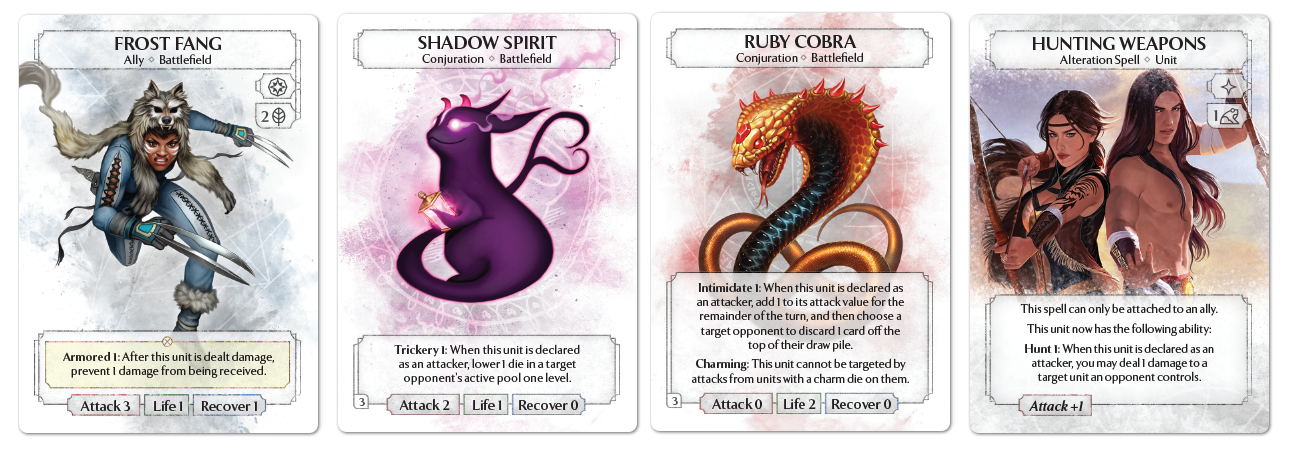
Taking it further:
Similarly to how Hope’s deckbuilding often revolves around Duplicate, Tristan’s deckbuilding does the same with Magnify. You want to be on the lookout for units with numerical abilities that benefit while attacking, especially those with low life totals. Frost Fang and Crystal Archer are quite difficult to handle, while Shadow Spirit and Ruby Cobra will force some horrendous groans across the table. Lobotomize 2 on Psychic Vampire is just plain rude, and speaking of vampires, Vampire Bat Swarm is supremely annoying with 1 extra attack. Additionally, you want to be on the lookout for cards that can give your units numerical abilities. Hunting Weapons is probably the strongest overall candidate, but you can also force some interesting situations with Power Through and/or Blinding Light. I think Hunting Weapons on Crystal Archer with Magnify might be one of the scariest attackers in the game.
That’s all for this week. I thought I had a preview for next week, but someone appears to have stolen my notes. Oh well, the truth can’t stay buried forever.
Andrew DiLullo is an animator, a game designer, and luckily also a writer. Having first discovered Ashes at the tail end of the first round of expansions in 2016, he’s been playing ever since and currently heads the Bay Area Ashes group in California. He was especially active in several community projects after Ashes was canceled the first time, and now puts his attention to Reborn as the game starts anew. He’s currently designing a board game in his spare time, and occasionally writes on his online journal: The Lighthouse Library.





